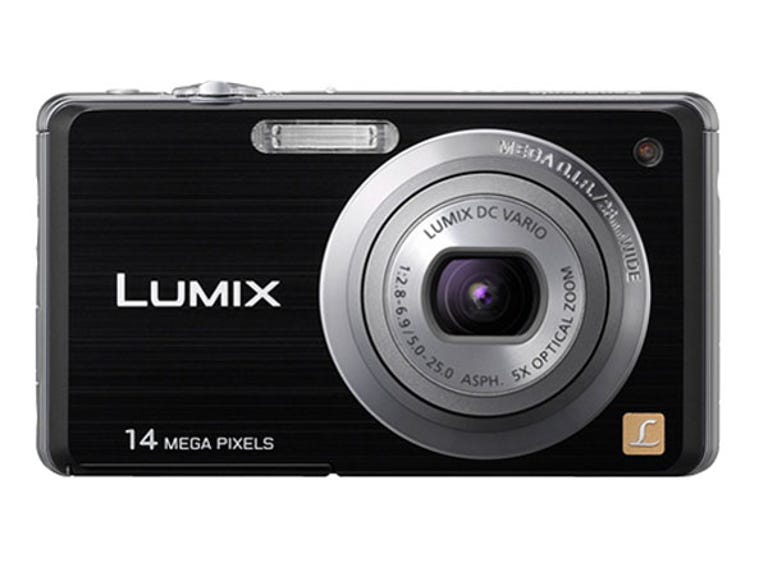 Why You Can Trust CNET
Why You Can Trust CNET Panasonic Lumix DMC-FH3 review: Panasonic Lumix DMC-FH3
Panasonic's FH3 is a perfectly functional compact camera at a great price. Experienced photographers will find some issues with image quality, but most users will enjoy the images produced by this camera.
Just looking for a simple, good quality point-and-shoot camera? The Panasonic Lumix DMC-FH3 might be for you. It's well priced, has a stack of features and image quality is good enough for most casual photographers.
The Good
The Bad
The Bottom Line
Design
At the top of the camera is a simple but functional arrangement of a power button, zoom rocker and an intelligent auto button, plus a power switch. At the back is a 2.7-inch LCD screen flanked by standard buttons. As per other Lumix compacts, there is also a switch that changes the camera from playback to camera mode.
The FH3 feels comfortable to hold in the hand and appears to be well built, with a nice metal finish around the lens. There's one side flap that takes care of the digital/AV out, but unfortunately there's no HDMI output provided. Measuring 55.2x98.4x24mm and weighing 125g, it's a lightweight but slightly chunky camera, lacking the streamlined form that characterises more expensive Lumix cameras.
At the base of the camera, the FH3 uses a Lithium-ion battery and a slot for SD/SDHC/SDXC cards that slot in together. For the style-conscious, it's available in black, silver and red.
Features

The features list on the FH3 turns up nothing out of the ordinary for a compact camera: a 14.1-megapixel sensor, image stabilisation in the form of Panasonic's Mega OIS, and a range of shooting modes. The Q Menu button underneath the four-way directional pad is a quick way to access many common shooting adjustments rather than delving into the main menus.
As this is one of the lower-end cameras in the Lumix range, the FH3 doesn't use a Leica-branded lens; instead it's a Lumix DC Vario one that extends to 5x optical zoom, and opens up to 28mm at the wide-angle end. The aperture range is f/2.8-6.9 from end to end.
The FH3 also has a high-angle LCD mode that makes it easier to view the screen when holding the camera up high to photograph a subject. In practice it works well, adjusting the viewing angle and brightness of the screen to best cater for these sorts of shooting situations.
A comparison between the image taken with normal picture mode (left) and intelligent auto (right). The pictures are very similar apart from a slightly brighter exposure when using intelligent auto. (Credit: CBSi)
Photo modes include standard automatic with some overrides, intelligent auto activated by the button on top, and scene modes and movie mode that can record videos in HD at 720p. For the price, it's hard to want any more features in this camera, apart from HDMI output.
Performance
The FH3 takes 1.9 seconds to start up and take its first shot without flash, which is reasonably quick for a camera of this class. Shutter lag is just average though, measuring 0.6 second without flash and in adequate light.
Continuous shooting makes the FH3 pump out just one full resolution JPEG frame every second; nothing special, but adequate enough for most uses. There are other options in the scene mode to take a high speed burst of shots, at a reduced resolution of 3 megapixels in a 4:3 aspect ratio, 2.5 megapixels at 3:2 and 2 megapixels at 16:9.
Image quality
The FH3 delivered perfectly acceptable images for web use and small prints, with good colours and not too much over-saturation present. However, there was a noticeable amount of barrel distortion at the wide end of the lens (28mm), which wasn't automatically corrected by the camera when it processed the JPEG. At sensitivity levels above ISO 400, noise began to affect image quality, and photos at ISO 1600 were mostly unusable except at very small magnifications.
A small portion of a 100 per cent crop (inset) of a larger image shows the amount of noise present at ISO 1600. However, for web use, this sensitivity wouldn't present too much of an issue. (Credit: CBSi)
Macro mode did not provide particularly strong results; even at a wide aperture like f/2.8 there was only a small amount of bokeh to bring out the subject from its background, and results did not appear as crisp or as sharply defined as we would have expected.
Images appeared sharpest at the centre of the frame, and unfortunately like so many cameras of its class, it is clear that there are too many megapixels on this camera for the lens and image processor to be able to resolve. As a result, even at low ISO levels such as ISO 80 and ISO 400 there were digital artefacts present.
Even at ISO 80, there are digital artefacts present, but nothing that affects web use or small prints. (Credit: CBSi)
Video quality was disappointing. In our test video, as seen below, the entire image is smeared in visible grain and lens flare is distinctly evident from the purple haloing. It's a peculiar phenomenon that hasn't previously exhibited itself in the company's range of Lumix cameras equipped with Leica lenses. The camera's swing tag mentioned that the HD movie was for PC only; however, the output file was a MOV motion JPEG, which should work fine on Macs.
Conclusion
Panasonic's FH3 is a perfectly functional compact camera at a great price. Experienced photographers will find some issues with image quality, but most users will enjoy the images produced by this camera.


